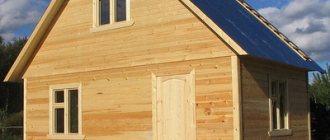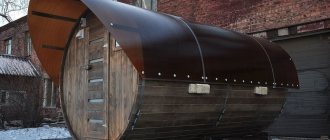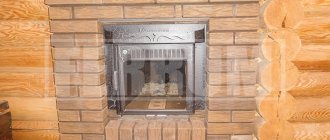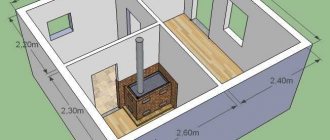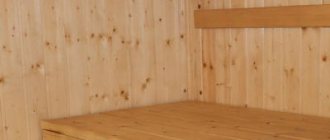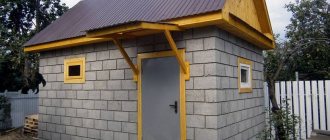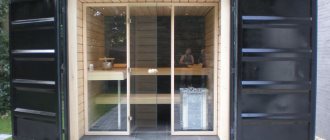Health has always worried scientists in all fields of science. Maslov's bathhouse combines many years of experience and know-how in scientific and engineering thought. The Maslova bathhouse appeared in the 80s and gained popularity among many lovers of the traditional Russian bathhouse. We will tell you how to build a Maslova bathhouse with your own hands and what features it has in today’s article.
You don’t need a large room for a Maslov bath.
X-ray
In this section we will try to answer the question, Maslova bathhouse, what is it?
We will not list the generally accepted and, let’s say, traditional principles of the Russian bath; we will focus on those that are original, unique and inherent only in Maslov’s system. So, this design consists of:
- Sweat rooms. A rather peculiar name for an internal separate bath area in which a peculiar adaptation of the body takes place before the main steam and phytomassage procedures. There is a ceramic sofa with an “anatomical profile” back. It is difficult to judge how “anatomical” the profile is, since different people have quite different heights and body constitutions to guarantee the creation of a truly universal design, with certain averaged parameters. The sofa is heated by hidden heating elements. Adjacent to it is a ceramic shelf with three heating zones: for the head, torso, and lower extremities. It should be noted that the temperature of each zone has independent adjustment and can be set individually. The vaulted ceiling is reminiscent of the family features of an oriental bath - hammam, and has lighting with variable intensity and color of the glow.
- Steam room with heat generator. We would like to especially emphasize that it is with a heat generator, and not a steam generator, which we talked about not so long ago. The steam room has a heated shelf with a lattice design to supply fresh air to the head of the steamer. There are also ceiling-type steam nozzles that direct a stream of steam to the shelves and a shower system with hot and cold water.
These two work areas are finished exclusively with ceramics and have built-in heating elements to maintain the overall temperature background. Smooth surfaces are heated by hidden pipelines with forcedly circulating coolant, vaulted surfaces are heated by a flexible electric heating cable. A few words about temperature regimes so that you can track trends in thermodynamic processes:
- At the floor level, or rather the bottom of the walls, the temperature is 45 degrees;
- At the level of the middle of the wall - 55 degrees Celsius;
- The upper third of the wall is 60 degrees;
- The surface temperature of the sofa and shelves is about 42 degrees Celsius;
- The temperature of the ceiling surface is about 75 - 80 degrees.
What kind of bathhouse is this, and why is it so popular?
Maslova's bathhouse is a kind of hybrid between a Russian stove and a Finnish sauna, which combines long and deep warming up of a person with the ability to steam in the presence of both dry and humid air.
Maslova's bathhouse achieved popularity thanks to the mild microclimate in the room, low enough temperatures that allow people with heart problems, hypertension, pregnant and lactating women to take bath procedures - in general, all those for whom visiting a classic Russian bathhouse and sauna is contraindicated.
The idea of creating such a bathhouse came to the inventor when he was trying to repair a Russian stove in his mother’s house. While inside the oven, the walls of which were slightly heated after heating, the owner began to sweat profusely.
And the whole point is that in ancient times, the Russian people were treated this way, when, after heating the hut and baking bread, the coal was raked out, boards were laid inside the oven, on which the patient was laid.
Prolonged stay in the oven at a temperature of 35-50C° caused severe sweating, increased blood flow, and increased oxygen saturation. As a rule, after several procedures, even seriously ill people got back on their feet.
Possibilities
The author declares full automation of all, without exception, processes that directly or indirectly affect the microclimate in the main functional areas of the bathhouse. Namely:
- The ability to set the ratio of temperature and humidity in modes from hammam to dry-air bath;
- Flexible microclimate adjustment in any zone;
- Control of all generating systems in real time;
- Quick access to operating mode, within 45 minutes;
- Programming modes by switching time and operating duration;
Important! There is no point in commenting on issues of electrical safety, in particular, the use of a step-down transformer for lighting and control, which are presented by the manufacturer as some kind of special achievement. They are clearly regulated and clearly stated in publicly available rules for the installation and operation of electrical installations. The “innovativeness” of the implementation should be described as follows: for about a century, human civilization has been using artificially low voltage in hazardous areas. And not even in such a critical place as a hot and humid bath, but, for example, in metal-cutting machines. Also, the lighting of the working area of a universal lathe has a voltage of 24 volts. In case of destruction of the lamp bulb or contact group with lubricating and cooling liquid, fatal electric shock to the operator can be avoided.
RBM interior: ceramics, stone, glass, metal
Maslova's bathhouse consists of one room - a kind of bath-shower cabin. The floor, walls, ceiling, sun loungers - everything here is covered with ceramic tiles, natural stone, glass mosaic. A shower is installed near the lounger so that the bathhouse visitor can wash while sitting or lying down, with maximum comfort. You can clean the steam room without any hindrance - there is a drain on the floor for water drainage.
A mandatory element of this steam room is a heat generator (steam generator), which is a rectangular stove-heater in a heat-insulated casing. To save space, the heat generator is usually fixed to the wall, at a height of 1.5 m from the floor.
Projecting statements onto reality
So, let’s try to carefully and objectively compare the statements of the developer and manufacturer with the real state of affairs, according to key, fundamental aspects:
No strain on the heart
The manufacturer claims that since you can heat the walls and ceiling of a steam room up to 45 degrees Celsius, you can sweat well without feeling discomfort from a rapid heart rate and high ambient temperature. It's not clear what the innovation is here. Low air mass temperatures have been used for centuries in hammams, and for decades in cabins equipped with infrared heaters. This is successfully used by tens of thousands of people with low tolerance to high temperatures, pardon the pun. A reasonable load on the heart allows you to train the heart muscle and make it easier to endure thermal stress.
Doesn't burn oxygen
You can burn out oxygen with an open flame in conditions of insufficient air exchange, when supply and exhaust ventilation is either ineffective or absent as such. Even our ancestors, who had no special understanding of the process of oxidation of organic fuel, wisely used the same black bath, only after extinguishing the fire. Also in this context, it is interesting to state that only Maslov’s bathhouse guarantees exceptionally clean air in the steam room, since steam generation occurs on stainless steel elements, without the use of stone backfill, which collapses and fills the air with the finest mineral dust.
Maslov's heat generator: device
Regardless of the type of bathhouse, built-in in an apartment or mobile, there is always a massive steel box in the steam room to produce a stream of hot water vapor. Maslov's heat generator exists in two versions - electric and gas, for stationary and mobile bathhouse models, respectively.
The device works as follows:
- Inside the massive body of the heat generator made of stainless steel, two electric heating elements or a coil made of heat-resistant steel 310 are mounted, laid on a U-shaped pipe;
- Metal rods are laid inside the central pipe of the heat generator; when electric heaters operate or the hot combustion products of diesel fuel move, their surface heats up to a temperature of 350-400°C;
- A ladle is installed at the inlet of one of the pipes, from which water drips in a thin stream into the hot pipe, releasing a stream of hot steam.
According to the author, Maslov’s heat generator creates a humid and hot atmosphere in the steam room of the bathhouse, like a regular heater. By adjusting the heating, you can achieve the most comfortable room temperature. In addition, the heat generator design virtually eliminates the risk of being burned by steam or scalded by boiling water, as happens when handling a classic sauna stove.
Advantages
The main and main advantage of the Maslov system can be considered very precise adjustment of the humidity and temperature of the bathhouse atmosphere. In the classic version of a sauna building, a stove is considered very successful if the humidity and temperature inside the steam room are adjusted no more often than once every ten minutes. In Maslov's bathhouse, most of the problems are taken care of by automation and an electronic control unit.
Water heating is ideal for mobile or portable bathhouse models. Anyone who has ever spent the night in frame buildings, in cars, or in tents knows how difficult it is to ensure a comfortable indoor temperature.
Maslov’s scheme allows you to easily adjust and maintain heating of any section of a mobile frame room, even in early spring, when temperature changes can reach 15-20°C. Thanks to the special design of the furnace, the heat generator and the built-in valve system, the high temperature in the steam room can be maintained indefinitely.
Flaws
This is not to say that the Maslova bathhouse does not have any disadvantages; despite all the attractiveness of the modern approach to heating and providing heat, the Maslova bathhouse remains a problematic design for two reasons:
- A huge number of control electric valves, which are controlled by a set of controllers and microcircuits, at the slightest failure, the stove and heat generator will cause a fire or thermal burns;
- The high cost of building a Maslov bathhouse. This is a high-tech facility, the price of which is 2-3 times higher than the best steam room, planned and assembled by a professional according to a classical design.
In addition, all elements of Maslov’s bathhouse, especially its most dangerous components - the stove and heat generator, directly depend on the availability of electricity. If the steam room loses power, the boiler, stove, pumps, and computer may fail.
We must pay tribute to V.V. Maslov, the safety and maintainability of the bathhouse were thoroughly thought out. In the absence of electricity, neither the heat generator nor the stove will cause thermal destruction of the structure or burns from boiling water. Most of the excess heat accumulated in the stove will transfer to the aluminum heating panels and be evenly dissipated indoors.
Construction technology
And now a brief instruction for daredevils who decided to build a bathhouse with their own hands.
- First, build a structure frame from metal that is not subject to corrosion. Install thermal and waterproofing.
- Then cover the frame with two layers of gypsum wall panels. This material (gypsum) is characterized by resistance to moisture and elevated temperatures.
- Attach temperature sensors and heat-resistant cable elements to the casing.
- Cover the structure with iron mesh (exclusively galvanized).
- Apply a layer of heat-resistant plaster to the surface.
- After the plaster has dried, install a layer of waterproofing material.
- The best material for cladding the Maslova bathhouse is natural stone (such as, for example, marble, soapstone and others). If you decorate a steam room with one of these materials, it will acquire healing properties, largely thanks to the stones.
- Divide the sunbeds into three zones (they were already mentioned earlier) and install temperature sensors in each of them.
- Use a sheet of tempered tinted glass as a door. Door frames can be used both wooden and iron.
- Install a ventilation system in the steam room (it has a very complex structure and will provide different modes). An ordinary hood is suitable for a locker room. When installing ventilation, use plastic boxes with a diameter of 12.5 cm.
Note! Be sure to equip the ventilation with an electrically driven throttle valve, as well as a special condensate collector.
- Also buy a special heating element that will be used to heat the stones. Such a heating element must be equipped with a double shell. The device itself must be made of heat-resistant stainless steel.
- Install the heating element on the wall about one and a half meters from the floor, cover it with special fire-resistant ceramic tiles.
That's it, you can safely start using it.
Note! Such heat generators (heating elements) are not only extremely efficient and economical. Their design is such that it completely eliminates burning out of the aromatic oil and burns.

